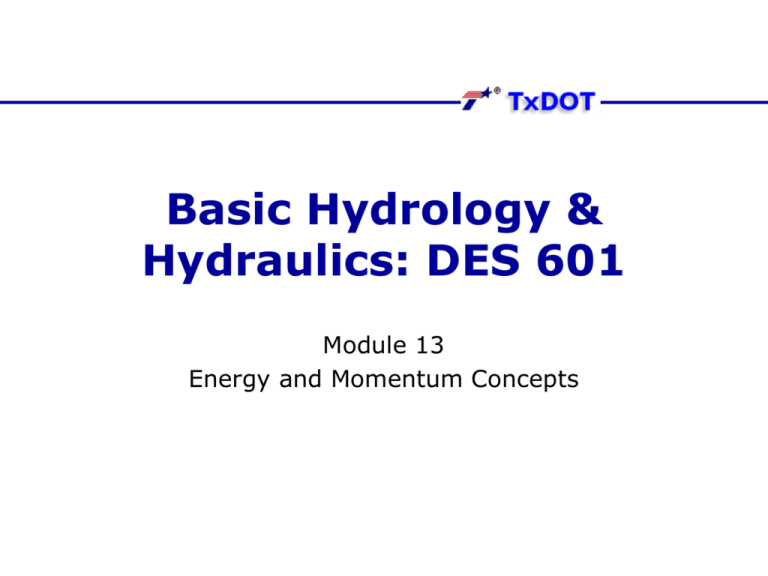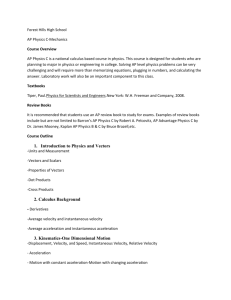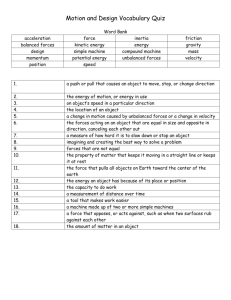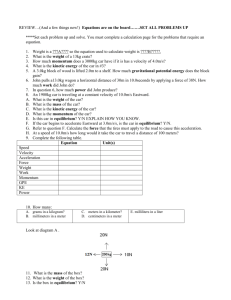DES601-Module13
advertisement

Basic Hydrology & Hydraulics: DES 601 Module 13 Energy and Momentum Concepts Energy of flow • Three kinds of energy gradients cause flow • Elevation (called potential energy) • Pressure (another kind of potential) • Kinetic (related to how fast water is moving) p1, v1 Elevation 1 p2, v2 1 Elevation 2 2 Module 13 Pressure • Pressure at point = p = g h • For US customary units, g = 62.4 lb/ft3 • Example: • At point 1, p1 = g h1 • At bottom of tank, pbottom = g hbottom hbottom 1 h1 • Pressure energy = h Module 13 Potential and Kinetic Energy • Potential energy is the sum of the elevation head and the pressure head • Sometimes called the static head • Kinetic energy is the energy of motion • Proportional to the square of the mean section velocity • The sum of potential and kinetic energy is the total energy (head). Module 13 Total energy • Express energy in consistent units, typically units of length (ft). • Elevation head (h) has units of ft. • Pressure has units of lb/ft2. • If we divide p by g (62.4 lb/ft3), we get units of ft. for the pressure head. • Velocity has units of ft/sec. • velocity head is v2/2g where g = gravitational acceleration. • Total energy (head) = h + p/g + v2/2g Module 13 Bernoulli Equation • If friction losses are neglected and no energy is added to, or taken from a piping system, the total head, H, which is the sum of the elevation head, the pressure head and the velocity head will be constant for any point on a fluid streamline. • This expression head conservation of head in a conduit or streamtube is known as the Bernoulli equation: 2 2 p v p v Z1 1 1 Z 2 2 2 1 g 2 g 2 g 2g where is: Z1,2 - elevation above reference level; p1,2 absolute pressure; v1,2 - velocity; ρ1,2 - density; g acceleration of gravity http://www.pipeflowcalculations.com/pipe-valve-fitting-flow/flow-in-pipes.php Module 13 Energy losses • Due to • Boundary resistance (friction losses) • Effects of changes in flow geometry (local losses) • Local losses often expressed as hL = K v2/2g in which K = the head loss coefficient • Friction losses commonly computed using empirical equation, such as Manning’s equation, Chezy equation, Darcy-Weisbach equation or HazenWilliams (water only!) Module 13 Energy Equation • If friction losses are included, the equation is called the energy equation 2 2 p v p v Z1 + 1 + 1 + hP = Z 2 + 2 + 2 + hT + hL r1g 2g r2 g 2g Added head (pump) Extracted head (turbine) Frictional Loss • Turbine extraction is probably uncommon for transportation infrastructure, but the other two (pumps and friction) are common Module 13 Momentum Concept • Momentum is defined as mass of object multiplied by velocity of object; these are vector quantities • The principle is that the change in momentum is equal to the forces on the object (fluid element) v v v gQ(V2 V1 ) F g Module 13 Momentum Concept • Force on a pier Module 13





